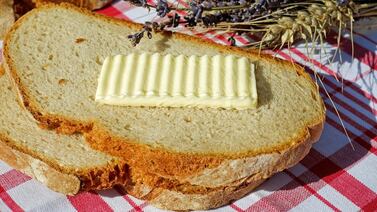To butter, or not to butter (your bread)? That is the question.
It might initially seem that there’s little to debate here. After all, where there’s bread – be it sliced white, airy artisanal sourdough or hot-from-the-tandoor naan – surely butter should be in close proximity.
But is that always the case? Does butter deserve a space at the table or a place on your toast, no matter what? Where do you store yours and how do you spread it? And what role does butter play in a sandwich, if any?
How do you spread butter?
These issues are contentious ones, so let’s ease our way in and first talk about technique. Some people are forceful, straight-from-the-fridge butter spreaders, while others favour a more pliable room-temperature slather. Some grate their butter, while a few are fans of the food hack that suggests cutting fridge-solid slabs with a cheese slicer.
The lactic, creamy tang of salted butter appeals to some palates, while others think mellower unsalted is the way to go.
Some subscribe to the idea that a dropped slice of toast will almost always land butter-side down. This is a pessimistic but quite correct point of view; it’s all to do with the angle of the toast as it slips from the plate and the time it has to rotate in mid-air.
Butter on bread, brioche and banana cake
No matter how you butter yours, when eating just bread (toasted or otherwise), we’d argue that butter is fundamental to your ultimate eating pleasure. There are, as always, a few exceptions to that rule, namely if the bread in question has been pulled from the oven seconds before or if gently swirling it in a pool of olive oil feels more fitting – when presented with an Italian-inspired grazing platter, mezze table or tapas-style menu, for example.
Those with more austere eating habits suggest that adorning a slice of golden, egg-rich brioche with yet more butter could be considered gilding the lily. Given that most of us don’t consume brioche on a daily basis, though, we’re inclined to say that when the opportunity arises, you might as well indulge yourself.
Whether that applies to baked goods that masquerade as bread – eyes on you, banana bread, loaf cake and the like – is another matter entirely and one that we’ll leave to personal preference. That said, a toasted tea cake that doesn’t drip with pools of melted butter frankly doesn’t bear thinking about.
What comes first, butter or jam?
What happens when you introduce another element – jam, jelly, spread or preserve – to the established partnership, though? Does the buttery stuff ever become redundant?
Here’s our much deliberated status on the matter: butter remains a constant until the additional ingredient in the potential triumvirate rivals it in terms of texture and richness. That means jam, marmalade, honey, Marmite, Vegemite (if you must) and the like should all be spread over a layer of butter (never the other way around).
Butter, cream and jam on scones
The only reason to forgo butter entirely is when the extra ingredient could credibly be considered a replacement. To illustrate our point, we’re going to steer you away from bread and butter for a moment and look instead to the very British scone.
Fiercely contested doesn’t even come close to describing the difference of opinion over how to serve a scone, with the Cornish adamant that jam then cream is the only way to go (which seems to be the queen's preference, too, according to her former personal chef). However, in the next county along, Devonians are as committed to a cream-first method.
Whichever way you prefer your scones, what we want to highlight is that the presence of cream in both methods makes the need for butter pretty much obsolete (or certainly excessive).
Butter on a peanut butter sandwich
Returning to toast and following this logic, if peanut butter is your topping of choice, there’s little need for a double butter whammy – even Elvis’s favourite sandwich calls for only peanut butter in the preparation (it is, however, fried in butter to finish, as the King was never one to shy away from excess).
It’s the same with avocado toast; when the topping is as rich and creamy as this one, the need for butter becomes obsolete. We’d also add cream cheese, labneh and Nutella to that list of butter substitutes.
The case for butter in a sandwich
While a smear of butter is standard in almost every European sandwich, in the US it’s rather more of a rarity (grilled cheese, withstanding).
Here’s why butter in a sandwich makes things better. A butter basecoat acts as a magical primer, softening the bread and adding just the right amount of moisture. It also provides a pleasing richness without ever threatening to overpower the flavour of the sandwich filling.
Perhaps most important of all, this thin yet all-important layer functions as an insulating barrier between the bread and the other ingredients, helping to guard against one of the greatest culinary tragedies of all: the soggy sandwich.









